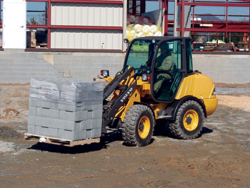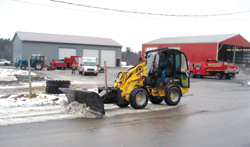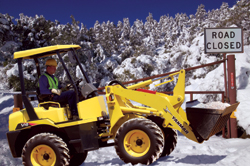A Machine for All Seasons
In a world with demanding work schedules, crews cannot afford to miss work because of weather constraints or inadequate equipment that can’t fulfill a project’s requirements. For contractors who face constant climate changes, such as those in the north who may have to halt operations for snow and ice, an ideal machine is what stands between getting out on the job and staying put in the office. However with the right piece of equipment, like a versatile compact wheel loader, the job can roll forward and contractors and landscapers can continue their projects without sitting on their hands and rescheduling work days.
With a sturdy design, durable wheels and a quick-attach plate to handle a variety of attachments, compact wheel loaders are a popular European machine and are becoming more prevalent as pick-and-place machines and tool carriers in North America. Whether it’s loading dirt or plowing through snow, placing pallets of cold brick or augering under the summer sun, a compact wheel loader is able to roll onto the jobsite and take on demanding projects — in most elements.
“A compact wheel loader is similar to a Swiss army knife,” says Andy Capps, product manager for Volvo Compact Equipment. “There’s an attachment that allows the compact wheel loader to fit virtually any application for any time of the year.”
Built with a large cab for premium visibility, four wheels and four-wheel drive for traction and a solid boom arm for lifting materials around a jobsite and running attachments, the compact wheel loader is designed for heavy-duty applications in a plethora of projects. Manufacturers are marketing these machines in a variety of different markets — landscaping, residential and commercial construction, agriculture, forestry and waste work.

Wheel loaders are categorized by horsepower (typically anything under 80 hp) and bucket size, which is measured in cubic yards (1 to 3 cu yd). Boasting an operating weight between 4,000 to 20,000 lbs and a lifting capacity range of 4,100 to 12,000 lbs, compact wheel loaders are stable and sturdy enough for projects large and small.
With compact wheel loaders, operators have the option of choosing an articulated or all-wheel-steer machine. An articulated loader excels in indoor applications, narrow spaces and on sensitive terrain (like pristine lawns). An articulated loader is easier to control and maneuver, navigating tight corners with heavy loads. An all-wheel-steer loader is known to have more stability and maneuverability on uneven grounds, such as slopes, and boast a rigid frame similar to a telescopic handler.
“It’s best to look at your intended applications and talk to a dealer,” says Auerbach. “You cannot really say if one is better. It all depends on looking at the application and picking out the right fit for you.”
The price of a compact wheel loader can range anywhere from $40,000 to $125,000, depending on the manufacturer, model size and options. Manufacturers of these versatile machines include Volvo, Caterpillar, Kubota, Terex, John Deere, Case, Yanmar and Wacker Neuson. Once an operator understands the basic features of a compact wheel loader, he or she can begin to benefit from the machine’s flexibility and solid build in applications best suited to complete a project. This means the ability to operate the machine in unique jobs and changing weather conditions.
Snow Savvy
Beside being able to handle its typical tasks of loader work in landscaping and construction, compact wheel loaders can easily transform into snow removers with the switch of an attachment. With the addition of a snow blade, broom, bucket or snow blower, an operator can become a master of snow applications.
“These loaders are becoming useful in snow removal, especially in areas like Michigan, Ohio and Illinois. They work well in mall and shopping center parking lots because of the operator’s visibility and ability to get into the corners and pull the snow out,” explains Capps. “They can be easily driven on the street as well. For instance, if an operator has three or four parking lots to clear along the same street, it’s very easy to clear the parking lot with a 12-ft blade and travel down the street with it to the next job.”
The machine’s maneuverability, visibility, access and traction all make the loader ideal for snow removal work in areas that require such a service, including commercial shopping center parking lots, walkways and common areas at universities and colleges and residential areas such as apartment complexes.
Snow blades are perhaps the most popular snow removal attachments for compact wheel loaders. These blades, which are available in widths of 10 to 16 ft, clear covered areas by pushing the snow away and off to the side. Brooms are ideal for light snow removal applications where the depth of snow fall is less than 3 in., notes Capps. Buckets are often used to haul off snow piles so the area is clear for traffic, whether it be vehicles moving about or people walking to their destination. Other attachments such as salt and sand spreaders are used to melt snow and ice and provide improved traction in those areas.
“A snow blade is a common attachment other than the typical bucket that will help with snow removal,” says Bill Gearhart, marketing and product manager for Yanmar Construction Equipment. “Snow blowers can also be used by wheel loaders if there is enough auxiliary hydraulic flow to power them.”
Other than changing out attachments, the compact wheel loader is readily available for snow removal duties. Even the standard tires operators use to roll onto delicate yards and rough construction sites are durable enough to meet the needs of slippery and slushy snow work.
“There are specialty tires for snow, but few customers buy them,” says Sam Meeker, Caterpillar’s compact and small wheel loader industry manager.
Capps adds, “As a general rule, most operators opt to use a standard tire. A good, all-purpose tire will provide enough traction whether it’s working on dirt or snow.”
Some operators may decide to use snow chains while working in the elements, especially on areas where traction is a concern such as slopes. However, those who use chains should be aware that they may cause damage to sensitive areas with the tire addition.
Overall, these cold season applications can take a toll on a crew, so one important machine consideration to make is the operator’s comfort. In snow removal applications, an operator may be on call 24 hours a day, seven days a week, and his or her comfort should be a priority to ensure safe and productive work. Adequate visibility, heat and overall security are important to keep an operator attentive and able to complete the task at hand.
|
|
“When working in winter applications, operator comfort is enhanced in a compact wheel loader more than in a skid steer,” says Auerbach. “Most have an enclosed cab with heating, so the operator can take off his jacket and sit comfortably. The machine’s side door allows the operator to enter and exit the wheel loader easily, while a skid steer entrance requires climbing over the bucket which may be slippery from the snow.”
Other comfort and safety features include a larger, all-glass cab for increased visibility, flat floor boards to sit comfortably and two or more operating lights to clearly view obstacles in the working area.
“Winter jobs often mean operating in low light or darkness, so lights on the loader are important,” says Auerbach. “For example, Wacker Neuson loaders come standard with two driving lights and four working lights, which are important because an operator doesn’t want to be working in a parking lot around cars at 4 a.m. without good light.”
Monitoring the Market
With the versatility a compact wheel loader offers to an operator working in different applications throughout the seasons, it’s no surprise that the market for these handy machines has grown over the past few years and continues to thrive today. For example, the compact wheel loader market has grown from selling around 1,400 units in 2003 to nearly 3,000 units in 2007, according to the manufacturers Compact Equipment surveyed.

Besides the machine’s capability to use different attachments, the loader’s basic construction features are making it a popular choice for contractors and landscapers. Its maneuverability, large cab design and overall productivity are making the loader an ideal replacement for equipment such as skid steers, tractors, telehandlers, backhoe loaders and forklifts.
“Compact wheel loaders offer many advantages over other material handling equipment, such as heavy-duty construction, better visibility to the work tool and surrounding environment, a more comfortable ride, less ground disturbance, lower operating costs and tire wear, as well as higher load capabilities,” says Meeker.
On average, a compact wheel loader is more expensive than a skid steer by 10 to 15 percent. However, Auerbach notes that the cost difference can even itself out through the lower operating costs of the machine vs. a skid steer, as well as different financing options available through equipment dealers.
“From an operating cost point of view, compact wheel loaders offer better fuel economy and less tire wear over a skid steer,” says Auerbach. “A set of tires on a skid steer can wear very fast, whereas compact wheel loader tires last longer and don’t disturb the ground as much. Landscapers appreciate that they can go over sensitive turf without destroying it.”
Whether a contractor works only in the summer months manicuring landscapes, or takes his show on the road year-round, a compact wheel loader is a one-machine powerhouse able to adapt to the seasons and handle projects despite the ever-changing elements. Its versatility and durable build allows crews to roll onto jobsites and perform numerous tasks, whether the day calls for pick-and-place operations on a busy construction site or clearing snow in a parking lot during the wee hours of the morning.
Pam Stask is assistant editor of Compact Equipment, based in Peninsula, Ohio.

 1. Ready, Set… Go!
1. Ready, Set… Go!



Comments are closed here.